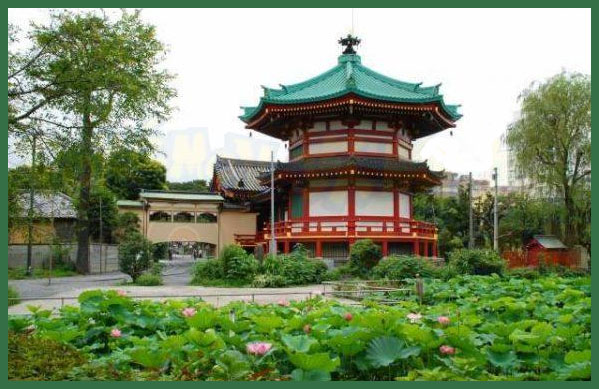. Famous Places and Power spots of Edo 江戸の名所 .
::::::::::::::::::::::::::::::::::::::::::::::::::::::::::::::::::::::::::::::::::::::::::::::::::::::::::::::::::::::::::::::::::::::::::::::::::::::::::::::::::::::::::::::::::::
Takinogawa 滝野川 / 瀧野川 Takinogawa district
北区 Kita, 滝野川一丁目から滝野川七丁目 from the first to the seventh sub-district
滝之川 / 滝の川 - Taki no Kawa, Takinokawa

The river Shakuji-I gawa 石神井川 became quite steep and fast at 板橋区加賀 Kaga in Itabashi and this part was called
Takinokawa 滝野川 "Waterfall River"
There used to be at least seven natural waterfalls of the river Shakuji-I gawa 石神井川 river Shakujii , also called 滝野川 Takinogawa in Edo.
. Edo no taki 江戸の滝 waterfalls in Edo .
There were two main sub-districts :
滝野川西地区 Takinogawa Western area
滝野川東地区 Takinogawa Eastern area
In 1889, the area was called
滝野川村 Takinogawa mura village
and in 1913
滝野川町 Takinogawa cho town
In 1923 it became part of Tokyo and was named
滝野川区 Takinogawa ku ward
In 1942, this ward was renamed
王子区 Oji ku ward
In 1967, the seventh sub-district, 滝野川七丁目 was added.

瀧野川 紅葉 Maple leaves at Takinogawa
広重 Hiroshige II
Ōji Takinogawa River
Takinogawa River is another name of the Shakujii River that runs through Ōji.
Asuka-yama was nearby, the current in this part of the river is rapid
and so the area received many visitors as a nature rich resort place
where some waterfalls such as Fudō-no-taki and Benten-no-taki can be seen.
- source : Tokyo Metropolitan Library -
..............................................................................................................................................

Takinogawabashi 滝野川橋 Takonogawa bridge
finished in 1961.
- source and more photos -
.......................................................................

Takinogawa kooen 滝野川公園 Takinogawa Koen Park
even with a waterfall in the park and a walk along the river.
..............................................................................................................................................
Takinogawa Hachiman Jinja 瀧野川八幡神社 Shrine
北区滝野川5丁目26−15

Built in 1202.
The main hall was restored in 1885.
The prayer hall was restored in 1922.
There used to be a market of vegetable seeds.

- Deity in residence
品陀和氣命(ほんだわけのみこと)Hondawake no Mikoto - 應神天皇 / 応神天皇 Ojin Tenno (200 - 310)

goshuin 御朱印 stamp - to win in sports 勝
- HP of the Shrine
- source : takinogawahachiman... -
..............................................................................................................................................
0oji Fudoo no Taki 王子不動之滝 Fudo Waterfall in Oji, Edo

Utagawa Hiroshige 歌川広重
There used to be at least seven waterfalls of the river Shakuji-I gawa 石神井川,
also called Takinogawa 滝野川 in Edo.
People came here in summer to feel the cool, have a snack and relax.
Now part of Nerima ward.
. Fudo Myo-O and waterfalls in Edo .
The statue of Fudo 滝不動尊 is now preserved at the temple 正受院 Shoju-In
(北区滝野川2-49-5) Kita-ku, Takinogawa.
. Edo no taki 江戸の滝 waterfalls in Edo .
..............................................................................................................................................
- quote -
Maple season at Takinogawa, Oji, Tokyo, c. 1910.
“A notice of the floral festivals of the year as observed in Japan demands some mention of the maple – for the reddening leaf of the maple, like the foliage of many other blossomless trees, is regarded as a flower in Japan.
“The rich tints of the changing leaves of certain deciduous trees hardly distinguishable from the colouring of blossoming shrubs, such as the azalea, form a favourite object of attraction during the Autumn months. The native term, momiji, which is commonly translated ‘maple’, is, strictly speaking, a general name applied to many trees which redden in the Fall.

“Of the maple itself, there are many varieties distinguished both by the form of their leaves and the tone of their changing colour. No garden is considered complete without its group of such reddening trees, placed beside some artificial hill towards the West, to receive additional splendour from the setting sun.
“… At Ko-no-dai, a famous prominence commanding a view of the whole plain of Tokio, there are some magnificent maple trees noted for their enormous size … About the end of October, in the glen called Taki-no-gawa at Oji, a suburb of Tokio, the slopes of a natural glen between the hills are planted with thick masses of these trees forming a most romantic spot where from the galleries of a rustic arbour the sight of the foliage in all its burning splendour may be enjoyed. Shinagawa and Meguro, other well known spots in the vicinity of the capital, have also good groups of maples which attract many sight seers. Picnicking and mushroom gathering are pastimes which accompany the viewing of the maple.
“In the poems and pictures of the country, the maple is associated with deer:
How full of sorrow seems the Autumn! when
In solitary rambles slowly straying,
Amid the russet foliage of the glen,
I listen to the lonely stag’s sad baying.”
– The Floral Art of Japan: The Flowers of Japan and the Art of Floral Arrangement, Josiah Conder, 1899
- source : oldtokyo.com... -
..............................................................................................................................................
岩屋弁天 Iwaya Benten - 弁天の滝 Benten Waterfall
松橋弁天洞窟 Matsubashi Benten cave does not exist any more.

北区滝野川3-88-17Kita ward, Takinogawa / 金剛寺 Temple Kongo-Ji

Bentendoo 辨天堂 Benten Do Hall
. . . CLICK here for more Photos !
. Edo roku Benten 江戸六弁天 Six famous Benten in Edo .
::::::::::::::::::::::::::::::::::::::::::::::::::::::::::::::::::::::::::::::::::::::::::::::::::::::::::::::::::::::::::::::::::::::::::::::::::::::::::::::::::::::::::::::::::::

. Takinogawa ninjin 滝野川人参 carrots .
::::::::::::::::::::::::::::::::::::::::::::::::::::::::::::::::::::::::::::::::::::::::::::::::::::::::::::::::::::::::::::::::::::::::::::::::::::::::::::::::::::::::::::::::::::

- - - To join me on facebook, click the image !
:::::::::::::::::::::::::::::::::::::::::::::::::::::::::::::::::::::::::::::::::::::::::::::::::::::::::::::::::::::::::::::::::::::::::::::::::::::::::::::::::::::::::::::::::::::
. Kita ku 北区 Kita ward, "Northern Ward" .
. Famous Places and Powerspots of Edo 江戸の名所 .
. Edo bakufu 江戸幕府 The Edo Government .
. Doing Business in Edo - 商売 - Introduction .
. shokunin 職人 craftsman, craftsmen, artisan, Handwerker .
. Legends and Tales from Japan 伝説 - Introduction .
[ . BACK to DARUMA MUSEUM TOP . ]
[ . BACK to WORLDKIGO . TOP . ]
- - - - - #takinogawa #waterfall #shakujii- - - -
::::::::::::::::::::::::::::::::::::::::::::::::::::::::::::::::::::::::::::::::::::::::::::::::::::::::::::::::::::::::::::::::::::::::::::::::::::::::::::::::::::::::::::::::::::





































